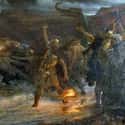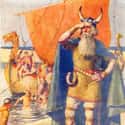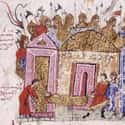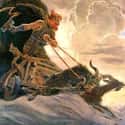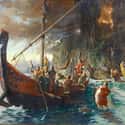-
(#1) Burning Funeral Boats On The Open Water Wasn't Really A Thing
The image of a flaming funeral ship drifting into the sea may be powerful but it's not totally accurate. It is true that some Vikings - especially important ones - were cremated in boats. But these ships were usually buried on land as part of the funeral ritual. They likely weren't sent into open water.
Though funeral traditions varied in the Viking world, many burials included grave goods, or items that the deceased might need in the afterlife.
-
(#2) Vikings Were In North America In 1021, WAY Before Christopher Columbus
Before Christopher Columbus "discovered" North America, Viking/Norse explorers made inroads into what is now Newfoundland at the turn of the 11th century. They even established a small village at L'Anse aux Meadows, on the northernmost tip of Newfoundland.
The L'Anse aux Meadows site, now a National Historic Site of Canada, was first excavated in the 1960s, but researchers could only estimate when the Vikings arrived there. In 2021, scientists announced they had used advanced technology dating tree rings to pinpoint the exact date the Vikings arrived: 1021, more than 470 years before Columbus.
The Vikings didn't stay there long, however - probably only around three to 13 years.
-
(#3) They Had Contact With Native Americans
Because of their exploration of North America, it's likely that Viking sailors had at least some contact with Native Americans. Inuits and Vikings fought multiple times in Greenland. Moreover, scientists have discovered a genetic link between some Icelanders and Native Americans, which suggests a Native American woman might have traveled to Iceland with Vikings.
Trade likely took place as well. The Maine Penny, a Norwegian silver coin dating to the late 1000s found in a large trove of archaeological objects in Maine in 1957. Some scholars have said the coin is evidence of at least some Viking contact in the United States, with others saying it likely was brought from Newfoundland at some point, and a few simply writing it off as a hoax.
-
(#4) They Believed Warriors Got To Bring Their Dogs Into The Afterlife
Vikings seemingly had strong bonds with their dogs. They believed that warriors' dogs could accompany to Valhalla, the grand hall where the most worthy warriors would gather in the afterlife. But in order to enter the hallowed halls of Valhalla, the dog would have to be dead. Dogs were thus sometimes sacrificed and buried with their masters.
-
(#5) Viking Warriors Didn't Wear Horned Helmets
Vikings have become synonymous with horned helmets. But the ubiquitous headgear seen in operas, comics, and TV shows probably wasn't worn by Viking warriors. They would have been unwieldy for close-quarter combat and a pointless affectation.
It's likely that these helmets were first linked to Vikings in the 19th century, thanks to a costume designer. Carl Emil Doepler created the costumes for Richard Wagner's Norse-themed operas. He probably based his hat designs on Greco-Roman artwork as well as helmets that old Germanic priests wore during ceremonies.
-
(#6) Vikings Engaged In Rap Battles
Vikings found creative solutions to rivalries. If two people ran into conflict, they could publicly needle each other. Flyting, from the Old Norse word for "provcocation," was an opportunity for a Viking to show off his verbal prowess by poetically insulting someone else.
Flyting became a feature of courts throughout the Viking world, including England and Scotland.
-
(#7) They Sold 'Unicorn Horns' In Their Extensive Trade Networks
Vikings are perhaps best known for their devastating raids on coasts and along rivers. But they were also traders connected to networks that stretched all the way to North America and the Middle East.
Among the goods that they circulated: narwhal tusks, which they sold as unicorn horns. Given the popularity of unicorns in medieval Europe - fueled by the belief that unicorns were real creatures - there was no shortage of wealthy buyers.
-
(#8) Vikings Weren't Always Blond-Haired And Blue-Eyed, Though They Sometimes Dyed Their Hair To Live Up To Beauty Ideals
Contrary to inaccurate - and racially charged - depictions of Vikings as exclusively blond-haired and blue-eyed, they were a culturally and ethnically diverse group with a variety of appearances.
To conform to Nordic beauty ideals, brown-haired male Vikings would sometimes use a strong soap with a high concentration of lye to bleach their hair blond. Some men would use the soap on their beards, as well. The lye soap had a practical application beyond looking trendy - it killed lice.
-
(#9) Gender Roles Weren't Totally Rigid
While Nordic societies were male-dominated, women enjoyed relative freedom, especially compared to other European cultures. Women married young, but could go on exploratory journeys with men, and made up a number of far-flung colonists. Women could inherit property, manage family finances, and request divorces. They were even able to get their dowry back in some cases.
Women also participated in roles that may have been closed to them in Western European society, since gender was slightly more fluid. Shield-maidens, or warrior women, color Nordic sagas, for example. Archeologists also discovered the grave of a high-ranking Viking warrior who was biologically female.
-
(#10) Some Norse Warriors Really Did 'Go Berserk' Before Battle
While they seem like the stuff of legend, there were actually Norse warriors called berserkers who went into battle seized by an uncontrolled fury. The term translates from Norse as "to change form," indicating strong men who fought wearing bearskins and were imbued with otherworldly power. Sagas of the time describe them as mad dogs who shrieked when running into combat and could slay an opponent with one blow.
Modern theories for what caused berserker rage usually revolve around intoxicants like mushrooms or strong alcohol.
-
(#11) Some Vikings Became Elite Bodyguards In The Byzantine Empire
Perhaps given their legendary fighting ability, Vikings became bodyguards for some of the most significant rulers in the pre-modern world. The Varangian Guard - a high-ranking unit made up of Vikings - protected Byzantine emperors from the late 10th century. The Varangian Vikings came to Constantinople by way of modern-day Russia. Though they continued to serve emperors, their status diminished by the 1200s.
-
(#12) Vikings Kept Bears As Pets
Vikings were known to keep animals. But they didn't limit themselves to the standard cats and dogs: Vikings also kept bears as pets. Bears were domesticated from cubhood. Iceland even created laws to regulate polar bear-ownership. According to one:
If a man has a tame white bear, then he is to handle it in the same way as a dog and similarly pay for any damage it does. A bear has no immunity in respect of injuries done to it if it harms people.
-
(#13) Vikings Didn't Stick To Europe
Viking ships sailed almost the length of the known world, reaching everywhere from North America to Constantinople. Archeological evidence and medieval sagas even suggest they sailed the Tigris River all the way to Baghdad. Many of these expeditions were either exploratory voyages or raids, and most Norse colonization was limited to the Northern Hemisphere.
Due to their contact with so many regions, the Viking world was large, expansive, and diverse.
-
(#14) They Had A Thriving Slave Trade
One of the purposes of Viking raids was to acquire human capital for a slave trade. Vikings captured and enslaved both women and young men while pillaging settlements everywhere from the British Isles to Eastern Europe. Indeed, taking enslaved captives may have been a motivating factor for Viking exploration and raids. The captured slaves were included in the lowest Viking social class, called “thralls,” and sold in giant slave markets across Scandinavia, Europe, and the Middle East.
Slaves didn't have rights and could be sold or used as the owner saw fit.
-
(#15) Far From Being An Unwashed Horde, Vikings Tried To Be Clean
Despite spending large amounts of time either at sea or raiding, Viking warriors took hygiene seriously. Excavations of Viking sites have turned up lots of hygiene tools, including tweezers, razors, combs, and ear cleaners.
Vikings also bathed at least once a week, much more frequently than contemporary Europeans, who often only bathed a few times a year. They also enjoyed natural hot springs, when available.
-
(#16) The Modern British Monarchy Can Trace Itself Back To The Vikings
Vikings - like Sweyn and Cnut - invaded and became rulers of England. Indeed, the last successful invasion of England resulted in a new monarchy that likewise had its roots in the Viking world.
In 1066, William the Conqueror of Normandy defeated English King Harold Godwinson at the Battle of Hastings and ushered in a period of Norman rule over England. The Normans - a word derived from "Norseman" - were the descendants of Vikings who had settled in northern France, though their society had developed Franco and Germanic accents over the centuries. Every English king and queen - including Queen Elizabeth I - claims descent from William, and thus his historical Viking ancestry.
New Random Displays Display All By Ranking
About This Tool
Our data comes from Ranker, If you want to participate in the ranking of items displayed on this page, please click here.

